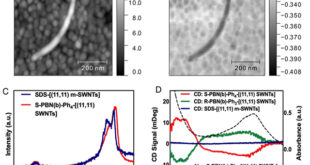Angewandte Chemie International Edition, Volume 51, Issue 33, pages 8212–8216, August 13, 2012.
Fabian Meemken, Dr. Nobutaka Maeda, Prof. Dr. Konrad Hungerbuhler, Prof. Dr. Alfons Baiker.
Department of Chemistry and Applied Biosciences, Institute for Chemical and Bioengineering, Honggerberg, HCI, 8093 Zurich (Switzerland) http://www.sust-chem.ethz.ch, www.baiker.ethz.ch.
Chemistry Department, Faculty of Science, King Abdulaziz University, P.O. Box 80203, Jeddah 21589 (Saudi Arabia).
Abstract
The mighty cinchonidine: A diastereomeric surface complex in the asymmetric hydrogenation of ketopantolactone on chirally modified Pt is monitored by in situ ATR-IR spectroscopy, in combination with modulation excitation spectroscopy and phase-sensitive detection. Cinchonidine bound to the surface with its quinoline ring is shown to induce the chiral environment through a C9O⋅⋅⋅H⋅⋅⋅OC interaction (see scheme).
Copyright © 2012 WILEY-VCH Verlag GmbH & Co. KGaA, Weinheim.
Additional Information
The demand for optically active compounds has escalated sharply in recent years, driven by industrial interests in pharmaceuticals, agrochemicals, flavors and fragrances. One of the elegant ways to produce enantiopure compounds is heterogeneous asymmetric catalysis. Simple addition of trace amounts of chiral auxiliary such as cinchona-alkaloid induces the stereocontrol at the metal surfaces in the hydrogenation of functionalized ketones. Such multi-phase catalysis systems offer economical and sustainable supply of enantiomers by reducing the waste management in industrial production processes. The past studies demonstrated a critical role of N-H-O type hydrogen bonding between quinuclidine N-atom of the chiral modifier, cinchonidine (CD), and the O atom of the keto carbonyl group of {Alpha}–ketoesters. In the recent article, the authors discovered the role of C9-OH group of CD in the enantiodifferentiating step using in situ attenuated total reflection (ATR) IR spectroscopy combined with modulation excitation spectroscopy (MES). The proposed C9-O···H···O=C interaction together with the N-H-O type hydrogen bonding was found to synergistically enhance the stereocontrol at the chirally-modified metal surfaces. Besides, adsorption-desorption experiments with enantiomers demonstrated that the chiral environment around the C9-O and the quinuclidine N showed the particular enantiodifferentiation toward the right-handed enantiomer. This new finding may assists in refining the present mechanistic models of the stereocontrol at the chirally-modified metal surface, hence lighting up a path for an innovative breakthrough in rational design of more efficient and sustainable catalytic systems.
 Advances in Engineering Advances in Engineering features breaking research judged by Advances in Engineering advisory team to be of key importance in the Engineering field. Papers are selected from over 10,000 published each week from most peer reviewed journals.
Advances in Engineering Advances in Engineering features breaking research judged by Advances in Engineering advisory team to be of key importance in the Engineering field. Papers are selected from over 10,000 published each week from most peer reviewed journals.

